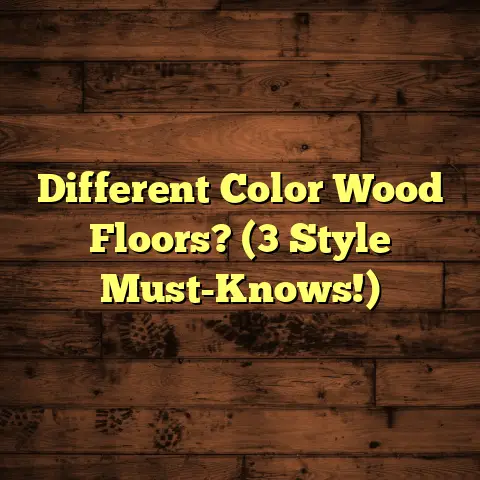Engineered Wood vs. Laminate: Which Wins? (4 Point Check!)
From toddlers turning living rooms into art studios, to furry friends testing the limits of scratch resistance, flooring takes a beating, especially in family homes.
Choosing the right flooring isn’t just about looks; it’s about creating a space where memories are made, spills are easily cleaned, and everyone feels comfortable.
Today, let’s dive into two popular options: engineered wood and laminate.
We’ll break down the pros and cons to help you make the best choice for your family’s needs.
1. Overview of Engineered Wood and Laminate
So, what are these materials, anyway? Let’s get clear on the basics.
Engineered Wood:
Imagine layers of plywood or high-density fiberboard (HDF) topped with a real hardwood veneer.
That’s engineered wood!
This construction gives it more stability than solid hardwood, making it less prone to warping or expanding with moisture.
It’s been around for a while, gaining popularity in the mid-20th century as a cost-effective alternative to solid wood.
Laminate:
Think of laminate as a high-tech photograph of wood, stone, or tile, sealed under a tough, clear wear layer.
It’s made of layers of composite wood pressed together, with that photographic image on top.
Laminate flooring emerged in the late 1970s and has become a go-to for budget-conscious homeowners.
Both offer great aesthetics, durability, and cost-effectiveness.
But which one truly wins for a family home? That’s what we’re here to find out!
2. The Four Points of Comparison
Alright, let’s get down to brass tacks.
We’re going to compare these two flooring options across four key areas:
- Durability and Maintenance
- Aesthetic Appeal
- Cost and Value
- Environmental Impact
Point 1: Durability and Maintenance
Okay, let’s face it: family life can be rough on flooring.
Kids, pets, spills, and everyday wear-and-tear all take their toll. So, how do engineered wood and laminate stack up?
Engineered Wood:
Engineered wood is pretty tough, thanks to its multi-layered construction.
The real wood veneer on top can withstand some abuse, but it’s still susceptible to scratches and dents, especially from pets with sharp claws or dropped toys.
Refinishing is an option, but it depends on the thickness of the veneer. Some thinner veneers can only handle one or two refinishings, while thicker ones can be sanded multiple times.
Maintenance-wise, engineered wood needs regular sweeping or vacuuming to remove dirt and grit.
Damp mopping is okay, but you want to avoid soaking the floor, as excessive moisture can damage the wood.
Laminate:
Laminate is a durability champ! Its tough wear layer is designed to resist scratches, stains, and fading.
This makes it a great choice for homes with kids and pets.
Spills are usually no problem, as long as you clean them up promptly.
However, once the wear layer is damaged, there’s no repairing it.
You’ll have to replace the damaged planks.
Maintenance is a breeze: sweep, vacuum, or damp mop as needed.
No special cleaners or treatments required.
The Verdict:
For pure durability, laminate takes the crown.
It can handle the chaos of family life with ease.
But, if you value the ability to refinish your floors and don’t mind a bit more maintenance, engineered wood is a solid option.
According to a study by the North American Laminate Flooring Association (NALFA), laminate flooring is “highly resistant to impact, scratches, surface water, and stains.”
Point 2: Aesthetic Appeal
Let’s talk looks! After all, you want flooring that makes your home feel warm and inviting.
Engineered Wood:
With its real wood veneer, engineered wood offers the authentic look and feel of hardwood.
You get the natural grain patterns, color variations, and textures that make wood so appealing.
It comes in a wide range of wood species, from classic oak and maple to exotic choices like Brazilian cherry or bamboo.
The finish options are also plentiful, from matte to glossy, smooth to hand-scraped.
This versatility makes it easy to match your existing décor or create a whole new look.
Laminate:
Laminate has come a long way in recent years.
Thanks to advances in printing technology, it can mimic the look of wood, stone, and tile with remarkable realism.
You’ll find laminate flooring in countless styles, colors, and textures.
Some even have embossed surfaces that mimic the feel of real wood grain.
While laminate can look convincing, it doesn’t quite capture the depth and warmth of real wood.
Up close, you might notice repeating patterns or a slightly artificial appearance.
The Verdict:
Aesthetically, engineered wood has the edge.
The real wood veneer provides a level of authenticity that laminate can’t quite match.
However, laminate offers a wider range of styles and colors at a lower price point.
So, if you’re on a tight budget or want a specific look that’s hard to find in engineered wood, laminate is a great choice.
I remember one family who chose engineered wood for their living room because they loved the natural warmth and character it brought to the space.
They said it made the room feel more inviting and cozy, perfect for family gatherings.
Point 3: Cost and Value
Okay, let’s talk dollars and cents.
Flooring is a big investment, so it’s important to understand the costs involved and the long-term value you’ll get.
Engineered Wood:
Engineered wood typically costs more than laminate, both for materials and installation.
You can expect to pay anywhere from \$3 to \$10 per square foot for the flooring itself, and another \$3 to \$8 per square foot for installation.
The total cost will depend on the wood species, veneer thickness, and complexity of the installation.
While the initial cost is higher, engineered wood can add value to your home.
It’s seen as a premium flooring option that can increase resale value.
Plus, the ability to refinish engineered wood can extend its lifespan and keep it looking beautiful for years to come.
Laminate:
Laminate is the budget-friendly choice.
You can find laminate flooring for as little as \$1 per square foot, and installation costs are typically lower than engineered wood, ranging from \$1 to \$5 per square foot.
This makes laminate an attractive option for homeowners on a tight budget or those looking to cover a large area.
While laminate might not add as much resale value as engineered wood, it’s still a durable and attractive flooring option that can last for many years with proper care.
The Verdict:
Laminate wins on cost, hands down.
It’s the most affordable option upfront and offers good value for the money.
However, engineered wood can be a worthwhile investment if you’re looking to add value to your home and appreciate the look and feel of real wood.
According to HomeAdvisor, the average cost to install laminate flooring is around \$4 per square foot, while engineered wood averages around \$6 per square foot.
Point 4: Environmental Impact
In today’s world, it’s important to consider the environmental impact of our choices.
Let’s see how engineered wood and laminate stack up in terms of sustainability.
Engineered Wood:
Engineered wood can be a sustainable choice, depending on the source of the wood.
Look for products that are certified by the Forest Stewardship Council (FSC), which ensures that the wood comes from responsibly managed forests.
The use of a real wood veneer means that less hardwood is used compared to solid hardwood flooring.
This can help conserve forest resources.
However, the manufacturing process of engineered wood can involve the use of adhesives and chemicals that can have environmental impacts.
Laminate:
Laminate is often made from recycled wood fibers, which can help reduce waste.
However, the wear layer is typically made of plastic, which is not biodegradable.
The manufacturing process can also involve the use of chemicals, such as formaldehyde, which can be harmful to human health and the environment.
Look for laminate flooring that is certified by Greenguard, which ensures that it meets strict indoor air quality standards.
The Verdict:
Both engineered wood and laminate have environmental pros and cons.
Engineered wood can be sustainable if sourced responsibly, while laminate often contains recycled content.
Look for certifications like FSC and Greenguard to ensure that you’re making an environmentally conscious choice.
I always advise my clients to ask about the sourcing and manufacturing processes of their flooring options.
Transparency is key when it comes to making sustainable choices.
3. Family Testimonials and Case Studies
Let’s hear from some real families who have chosen engineered wood or laminate flooring for their homes.
The Smiths (Engineered Wood):
“We chose engineered wood for our living room because we wanted a warm and inviting space for our family to gather.
The natural wood grain and color variations add so much character to the room.
We have two young children, and while we’re careful to clean up spills and avoid scratches, we know that we can refinish the floors if needed.
It was definitely worth the investment for us.”
The Joneses (Laminate):
“We have three kids and two dogs, so durability was our top priority.
We chose laminate for our kitchen and family room because it can handle anything our family throws at it.
Spills, scratches, muddy paws – no problem! Plus, it was so affordable, which was important for us as we were renovating our entire house.
We’re really happy with how it looks and how easy it is to maintain.”
The Millers (Mixed):
“We used a combination of engineered wood and laminate in our home.
We put engineered wood in the formal living areas and bedrooms, and laminate in the high-traffic areas like the entryway and hallways.
This allowed us to get the look and feel of real wood where it mattered most, while still staying within our budget and ensuring durability in the areas that needed it.”
These testimonials highlight the diverse needs and preferences of families when it comes to flooring.
There’s no one-size-fits-all answer.
Conclusion: Making the Right Choice for Your Family
So, which wins: engineered wood or laminate?
The truth is, there’s no clear winner.
The best choice depends on your family’s specific needs, lifestyle, and budget.
Let’s recap the key findings from our four-point check:
- Durability and Maintenance: Laminate is more durable and easier to maintain.
- Aesthetic Appeal: Engineered wood offers the authentic look and feel of real wood.
- Cost and Value: Laminate is more affordable, while engineered wood can add value to your home.
- Environmental Impact: Both have pros and cons; look for certifications like FSC and Greenguard.
As you make your flooring decision, I encourage you to consider the following:
- Your Budget: How much can you afford to spend on flooring and installation?
- Your Lifestyle: Do you have kids, pets, or a lot of foot traffic?
- Your Aesthetic Preferences: What look and feel do you want to create in your home?
- Your Values: Are you concerned about sustainability and environmental impact?
By carefully weighing these factors, you can choose the flooring that’s right for your family and create a space that you’ll love for years to come.
Remember, your flooring is more than just a surface to walk on.
It’s the foundation for family memories, gatherings, and daily life.
Choose wisely!





